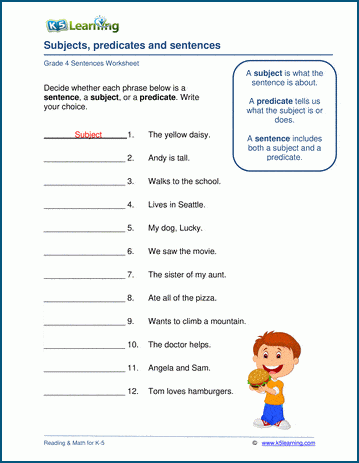In English grammar, a sentence is made up of two main parts: the subject and the predicate. The subject is the person, place, thing, or idea that is doing or being something in the sentence. The predicate, on the other hand, is the part of the sentence that tells us what the subject is doing or being. Understanding the relationship between subjects and predicates is crucial in constructing clear and effective sentences.
Here is a list of subjects and predicates to help you better understand how they work together in a sentence:
List of Subjects and Predicates:
- Subject: The cat Predicate: is sleeping
- Subject: Maria Predicate: loves to dance
- Subject: The sun Predicate: is shining brightly
- Subject: My dog Predicate: barks loudly
- Subject: The book Predicate: tells an exciting story
When constructing sentences, it is important to ensure that the subject and predicate agree in terms of number and tense. For example, if the subject is singular, the predicate should also be singular. Similarly, if the subject is in the present tense, the predicate should also be in the present tense. This agreement helps to maintain clarity and coherence in writing.
Subjects and predicates can vary in complexity, with some sentences containing multiple subjects or predicates. In these cases, it is important to ensure that each subject and predicate is clearly identified and that they are connected in a logical and coherent manner. By understanding how subjects and predicates work together, writers can create sentences that are grammatically correct and effectively convey their intended meaning.
Overall, subjects and predicates are essential components of a sentence that work together to convey meaning and provide structure. By mastering the relationship between subjects and predicates, writers can create clear, coherent, and effective sentences that effectively communicate their intended message.
Remember to always consider the subject and predicate when constructing sentences to ensure that they are grammatically correct and effectively convey your message to your audience.
